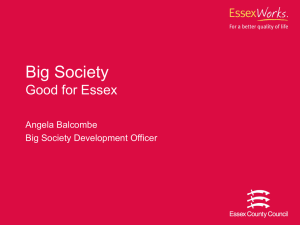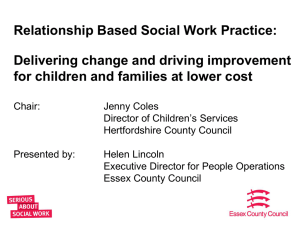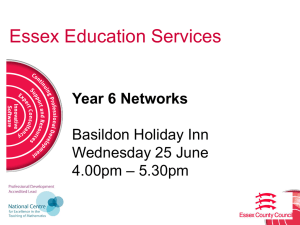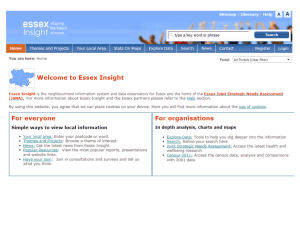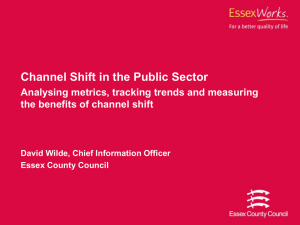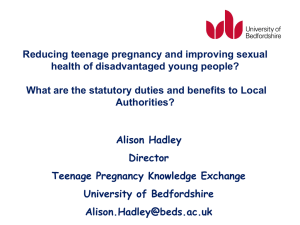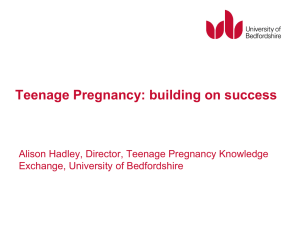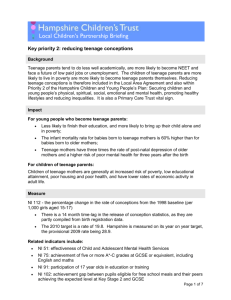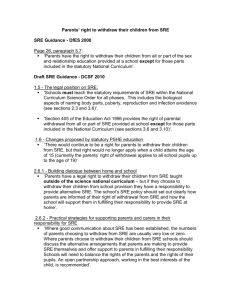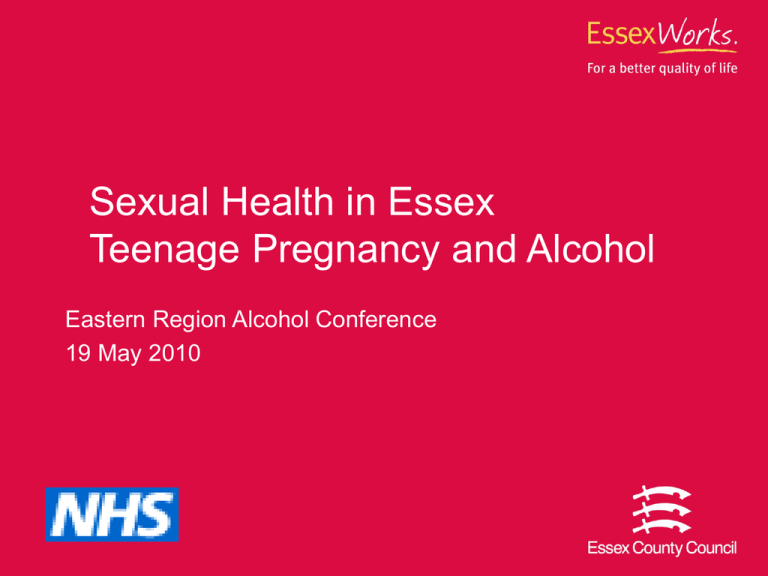
Sexual Health in Essex
Teenage Pregnancy and Alcohol
Eastern Region Alcohol Conference
19 May 2010
Social Exclusion Unit’s Report
June 1999
The 10 Year strategy has two main goals:
1. To halve the rate of conceptions among under 18s by 2010
and establish a firmly downward trend in conceptions under
16, within a broader strategy to improve sexual health.
(Renewed PSA 14 Increasing the number of young people
on the path to success)
2. To get more teenage parents into education, training or
employment, to reduce their risk of long-term social
exclusion with a target of 60% participation by 2010.
2
Essex data:
2006/08 Under 18 conception rate 32.2
1998-2008 + 15.6% reduction
England
East England
50
Under 18 conception rate per 1000
Essex County
40
30
20
10
0
1997
1998
1999
2000
2001
2002
2003
2004
Year
3
2005
2006
2007
2008
2009
2010
Name
U18 con
rate
97/99
Nos
U18
Con
Rate
2006/08
Nos
%change
97/99-06/08
%lead to
abortion
97/99
%lead to
abortion
06/08
Deprivati
on
Quantile
(5 = most
dep)
Basildon
55.5
516
41.6
413
-22.2
44.6
53
4
Braintree
33.1
226
33.3
269
+0.9
49.6
52
2
Brentwood
20.6
74
14.9
62
-32.7
60.8
77
1
CastlePoint
32.7
148
31.4
166
-3.8
58.1
55
2
Chelmsford
26.3
231
28.1
268
+2.8
47.2
59
1
Colchester
38.0
313
34.9
316
-13.6
43.5
46
2
Epping For
30.8
172
27.9
197
-3.7
54.7
77
2
Harlow
46.4
202
46.3
209
-6.1
45.5
56
4
Maldon
24.2
72
23.3
81
-1.5
51.4
52
2
Rochford
28.4
121
25.6
124
-10.9
60.3
68
1
Tendring
45.8
286
41.2
322
-6.6
33.2
40
4
Uttlesford
15.6
63
19.5
87
+22.7
61.9
69
1
Source: ONS 2010
4
Rate/100,000 population (15-59 years)
5
400
350
300
250
200
150
100
50
0
Source: Essex Health Protection Unit Annual Report, 2008
Local authority area
Brentwood
Epping Forest
Rochford
Tendring
Uttlesford
Maldon
Braintree
Castle Point
Celmsford
Basildon
Southend on Sea
Harlow
Thurrock
Colchester
STIs in Essex
Chlamydia in Essex
Key risk factors for teenage pregnancy
Risk behaviours
Education-related factors
Family/Background factors
NB: It is the presence of a number of risk factors that increase
the likelihood of becoming a teenage parent. It is not a
forgone conclusion. Neither should any factor be taken as an
indicator on its own.
6
Risk Behaviours:
7
Early onset of sexual activity
Poor contraceptive use
Mental health/ conduct disorder/ involvement in crime
Alcohol and substance misuse
Teenage motherhood
Repeat abortions
Risk Behaviours:
Early sexual activity
Girls having sex under-16 are three times more likely to
become pregnant than those who have sex post-16
8
Behaviours:
Poor contraceptive use
A quarter (25%) of boys and a third (33%) of girls who
left school at 16 with no qualifications did not use
contraception at first sex (compared with 6% of boys
and 8% of girls who left post-17 with qualifications)
9
Risk Behaviours:
Alcohol and substance misuse
Regular smoking, drinking and drug-experimentation
increases risk of under-16 sex for both young men and
young women
Teenagers who have sex under the influence of alcohol are
less likely to use contraception and more likely to regret the
experience
10
10 Key Factors for Effective Strategy
Supporting parents
To discuss sex &
relationships
SRE in schools
and out of school
settings
Young people friendly
Contraceptive services
Building aspirations
and self esteem
TP Champion
Strategic leadership
Strong use of
local data
Strong messages
to young people
and partner agencies
Workforce training
on SRE
Targeted SRE work
with young people
at risk
Strong youth service
things to do,
places to go
11
Building Resilience
Individual
Workforce
Virtual spaces
Youth
settings
12
Family
School
Community
Community resilience: Trading Standards
•
•
•
•
•
•
13
Age Restricted Sales
Gathering Intelligence
Targeting Resources
Delivering Business Advice
Test purchasing
Enforcement, License Reviews and
Prosecutions
Community resilience: Trading Standards
Alcohol Test Purchases
YEAR
TESTS
SALES
% FAIL
09/10
270
27
10
08/09
398
57
15
07/08
472
99
21
06/07
343
93
27
14
Community resilience: Trading Standards
Education
•
•
•
•
•
15
Crucial Crew events
Theatre Workshops
Film Competition
Businesses
Elected Members
Shared messages
•
Teenage Pregnancy Partnership Board and EDAAT shared
Communications project delivered across the Christmas and New Year
period to maximise the impact of shared messaging to young people
given the higher alcohol related incidents and the higher conception rate
trend in first quarter.
•
Outreach youth activities in clubs and bars to promote sensible drinking
and linking the work in some areas to Chlamydia screening initiatives.
•
Joint training with front line staff: SHAFT, Delay, Insets with PSHE/CPD
students, Midwifery Students at ARU, Sexual Health Training at ARU,
Police Conference and Schools.
•
EYPDAS: Essex young people’s drug and alcohol service. Targeted
and specialist treatment service that through its use of assessment tool,
will support young people to access CASH services.
•
Essex SRE Framework provides scenario based activities to explore
risk and the management thereof including alcohol and sex.
16
Healthy Schools Enhanced Model
• Have a planned and progressive approach to
SRE/PSHE education which reflects developmental
needs of children and young people, by building on
what has gone before and recognise the links
between SRE and other aspects of PSHE education,
for example the role of alcohol in risk taking
behaviour.
• Enhanced model focus on SRE/Conception rates,
Substance/alcohol misuse, emotional health and
wellbeing and obesity. Pilot in 46 schools 2010/11.
17
Young people’s involvement
• Essex YEA developed DVD to support the
development of SRE as a key priority.
• Essex YEA supported the development of Alcohol
Resource for Youth Settings
• Mystery Shopping activities
• Youth Health Trainers
• Peer educators
• As researchers in their own right: Project supported
through NCB at ARU to look into online bullying
• Theatre in Education
18
Risks and challenges
• Complex issues
• All have a part to play but each stakeholder needs to
know its role and remit
• Performance management and evaluation of impact
• Duplication of effort and spend unless planned and
implemented strategically
• Workforce development needs to keep pace
• Shrinking pool of resources
• Maintaining a sex positive approach whilst ensuring
high priority given to Safeguarding
19
Next steps
• Risk and resilience methodology
• JSNA profiling and GIS Mapping shared across the partnership
supporting the refresh of the CYPP
• Teenage Pregnancy Self Assessment ensuring that it is not seen
in in isolation- Essex Inequalities Plan
• Enhanced Healthy Schools Roll out following pilot activity (46
schools)
• Children’s Trust “Relationships, Sexual Health and Guidance for
Young Parents” Policy.
• Integrated joint commissioning
• A One Essex approach
20
Any questions……..
?
21
Contact details
• Jacquie Sheehan: Essex Teenage Pregnancy
Lead
• Karen Hammett: Teenage Pregnancy Project
Worker
22

